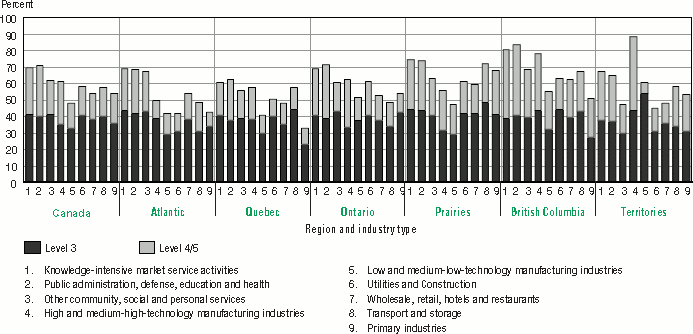
Figure 4.6B
1. The labour force population is defined as respondents who are either employed or unemployed (looking for work).
Note: This figure contains certain unreliable estimates. Consult the table 4.6 in Annex A for the standard error of each estimate.
Source: International Adult Literacy and Skills Survey, 2003.
Being employed, the type of job held, and the industry in which one works are all associated with literacy and numeracy proficiency. Previous research has also established that employment earnings are related to literacy proficiency along with many other factors such as education and gender. Green and Riddell (2001) demonstrate that literacy has a large effect on earnings, equivalent to about onethird of the estimated “wage return on education.” They find that an increase in an individual’s position on the distribution of literacy scores of ten percentiles results in a three percent increase in earnings (Green and Riddell, 2001). Previous research has also established that earnings differ for men and women, though the gap in earnings has narrowed slightly over the past decade (Drolet, 2001).
Figures 4.7 A to D show a clear relationship between high prose literacy proficiency and high earnings. However, the relationship between prose literacy and earnings is generally stronger for women than for men both at the national and regional levels. Just under one-third of men earning $60,000 a year were at the highest level of prose literacy (Level 4/5), compared to 15 percent among those earning less than $20,000. The difference is even greater for women – 50 percent of women with annual earnings of $60,000 or above are at prose literacy Level 4/5 compared with 19 percent who earned less than $20,000.
A much higher percentage of men than women earning at least $60,000 a year are at the lowest levels of literacy - one in four men and fewer than one in ten women nationally. Similarly, in the next highest earnings category, $40,000 up to $60,000, about one in three men compared with less than one in five women are at the lowest levels of prose literacy.